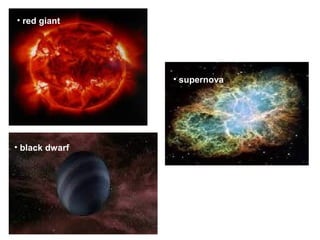The life of stars
- 1. THE LIFE OF STARS BY EMMA FERNÁNDEZ DE LA PRADILLA, TATYANA BERGETH AND ROCÍO CUADRA
- 2. The life of the stars Nebula. A nebula is a cloud of gas (hydrogen) and dust in space. Nebulae are the birthplaces of stars. types of nebula • Emission Nebula • Reflection Nebula • Dark Nebula • Planetary Nebula
- 3. types of nebula • An Emission Nebula e.g. such as Orion nebula, glows brightly because the gas in it is energised by the stars that have already formed within it. •In a Reflection Nebula, starlight reflects on the grains of dust in a nebula. The nebula surrounding the Pleiades Cluster is typical of a reflection nebula.
- 4. types of nebula • Dark Nebula also exist. These are dense clouds of molecular hydrogen which partially or completely absorb the light from stars behind them e.g. the Horsehead Nebula in Orion. • Planetary Nebula are the outer layers of a star that are lost when the star changes from a red giant to a white dwarf.
- 7. • red giant • white dwarf • black dwarf • supernova
- 8. RED AND WHITE DWARFS Red dwarfs are small and relatively cooler star. Their range in mass from a low of 0.075 solar masses, to about 50% of the Sun and have a surface temperature of less than 4,000 K. Red dwarfs are by far the most common type of star in the Milky Way, at least in the neighborhood of the Sun, but due to their low luminosity, individual red dwarfs cannot easily be observed. From Earth, they can´t be seen without a telescope. A white dwarf, also called a degenerate dwarf, is a stellar remnant composed of electron-degenerate matter. They are very dense; a white dwarf's mass is comparable to the Sun’s, and its volume is comparable to the Earth’s. Its luminosity comes from the emission of stored thermal energy. The nearest found white dwarf is Sirius B, and it’s 8.6 light years away. There are currently thought to be eight white dwarfs among the hundred star systems nearest the Sun.
- 9. •white dwarf red dwarf
- 10. What is a black hole?
- 11. How big are black holes? • Smallest black holes • Stellar black holes • Supermassive black holes
- 12. • How do black holes form? • How were they discovered?
- 13. • Could a Black hole destroy The Earth?
- 14. SUPERNOVAS • What is a supernova? • Where do they take place?
- 15. • What causes a Supernova? • 1- occurs in binary star system • 2- occurs at the end of single stars lifetime
- 16. Why scientists study Supernovas? • Supernovas burn for a very short period of time however they can tell a scientist a lot about the Universe. There are 2 types: • No hydrogen lines • Hydrogen lines















